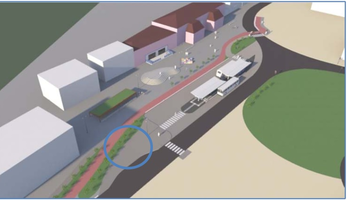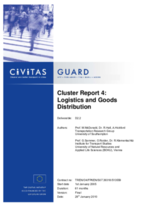Planning public transport system
Thematic areas
Collective passenger transport & shared mobility
- Ride sharing
- Car sharing
- Bike sharing
- Accessibility
- Intermodality
- Service improvements
Summary
There was no organized public transport system within the City of Koprivnica. In this measure the basis for the development of a public transport system in Koprivnica was established by conducting an intermodality study on various combinations of sustainable transport modes. The city aims to develop a public transport system which will connect various options of regional public transport bus service) and the new PT inside the city. The system will comprise an integrated service of regional transport operators, including an integrated ticketing system and an intermodal passenger terminal. A feasibility study on integrated transport solutions will also be conducted.
Implementing sustainable mobility
The City of Koprivnica aimed to develop the first public transport system which would connect various options of regional public transport (railway and bus service) and the new PT inside the city. It would be the first integrated public transport in the towns and cities of a similar size in the wider region. The system would comprise an integrated service of regional transport operators with a choice of innovative and attractive new transport means and service modes: electric minibuses (see measure K2.2) , together with the campus and city rental bike system. In the measures various intermodality combinations were to be tested in order to reach optimal solutions and to ensure the smooth flow of passenger and freight transport. Innovative services were also to be tested such as demand responsive public transport, collective taxis as well as public car-sharing scheme. The design of an integrated ticketing system aims to contribute to a more efficient passenger flow and produce solutions especially attractive to young dynamic people looking for more efficient mobility options.
The main objectives of this measure were to:
- Establish the basis for the development of the public transport system in Koprivnica
- Explore possibilities of integrating various transport modes into an efficient and viable system
- Study various combinations of sustainable transport modes in order to find the most efficient ones for the small town context
- Establish the basis for intermodality of various options
- Test various combinations of possible options in order to reach the desirable modal split of 30% of PT users
Progress
Before DYN@MO there was no organized public transport within the City of Koprivnica. The regional railway system and regional bus services transport passengers to the main stations which are situated at a short distance from one another at the western edge of the town centre. The only public transport inside the city referred to organized school buses and factory buses which have been used for transporting workers to the industrial zone at the northern edge of the city.
Several sustainable transport projects as well as a Local Agenda 21 Action Plan have raised the public awareness and promoted soft mobility modes such as walking and especially cycling. However, the lack of public transport has been acutely felt and the use of private cars is still the predominant transport mode.
The share of regional public transport in the modal split is modest, while the potential of the existing railway line has never been fully explored or supported. There has been no intermodality of the service of two regional public transport services which would benefit both operators.
The City of Koprivnica is a growing regional industrial and commercial centre which is currently developing a regional university. The potential increase of the city’s young population by almost 15% calls for the introduction of state-of-art transport solutions in order to answer the needs of the young dynamic generation as well as other categories of citizens who have been used to a high quality of life in their city.
Planning & preparation
- Development of the initial concept of public transport based on transport providers’, local and regional spatial planning and transport policies
- Presentation of the concept to stakeholders and achieving their commitment
- Initial agreement of public transport service providers
- Promoting internal discussions and participation between the main stakeholders
Implementation & demonstration
- Survey of current transport modes for the wider city area for various transport users
- Data collection on potential users – numbers, interest, barriers
- Study of various service modes based on the collected data
- Workshops with stakeholders aimed at designing the public transport system
- Feasibility study of intermodal transport solutions
- Design of intermodal passenger terminal and introduce it to all of the administrative departments as well as to the citizens and other stakeholders
- Development of an integrated ticketing system
- Planning and design of the overall system of public transport
- Planning of the bus infrastructure, bus stops Testing of various models of public transport for analysis and establishment of best solutions
- Elaboration of project documents for public transport
Outcomes
Tangible outputs:
- Study on various models of public transport system in Koprivnica
- Developed integrated ticketing system ready for use
- Feasibility study of intermodal transport solutions
- Architectural design of intermodal passenger terminal
- Design of bus infrastructure, bus stops,
- Reconstruction of bus stops
Expected outcomes in the short- to medium-term:
- Analysis of the public transport potential in Koprivnica
- Preliminary design of the intermodal passenger terminal
- Feasibility study of intermodal transport solutions
- Elaboration of project documents for public transport
Expected outcomes in the mid- to long-term:
- Developed study of public transport system in Koprivnica
- Functional integrated ticketing system
- Architectural design for intermodal passenger terminal
- Reconstruction of bus stops









